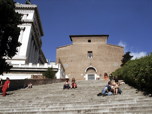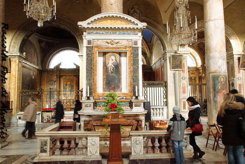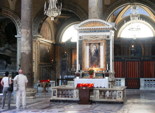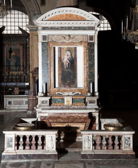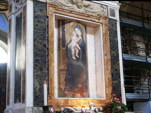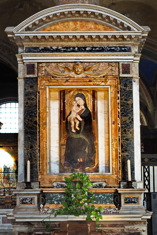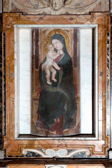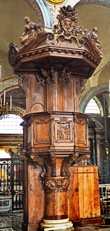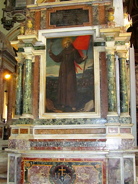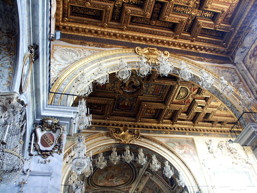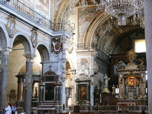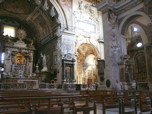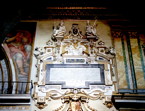Santa Maria in Aracoeli is the city church of Rome, a 13th century minor basilica and former convent
church on the Campidoglio. The church is dedicated to the Blessed Virgin Mary of the Heavenly Altar
("Aracoeli").
As a reference the plan of the basilica can be found
here
According to a 4th century legend, the
Emperor
Augustus, disturbed by rumors that the Senate was about to honor him as a God, consulted the
Tiburtine Sibyl, who prophesied the
descent from the skies of "the King of the ages." As she spoke, the Emperor beheld a marvelous vision - the Virgin
standing on an altar in a dazzling light and holding the baby Jesus in her arms - and heard a voice which said:
"This is the altar of the Son of God." Of course, the Emperor immediately raised an altar on the site, the Ara Coeli, or
altar of the heavens.
The legend is mentioned in the
Mirabilia,
c. 1140.
The first church was built in the 6th century by Byzantine monks, on the the ruins of a temple to
Juno Moneta (home of the early Roman mint, hence our word "money"). After
some time, probably no later than the 10th century, the
Benedictines replaced the Greeks. In 1249, a Papal bull granted the church to the
Franciscans, and that is when the present
church was built, incorporating many elements from the older church.
In the 14th century, Cola di Rienzo seized
power in Rome, and proclaimed himself Tribune and Liberator of the Holy Roman Republic. After winning a battle
against the nobles, he dedicated his sword at the altar of Santa Maria in Aracoeli. Cola di Rienzo was later lynched as a demagogue in 1354,
in the place where his statue now stands at the bottom of the Aracoeli ramp. In the middle ages, condemned criminals were executed at the foot of the steps
On 15th October, 1764, the British historian
Edward Gibbon sat in this church when, according to himself, "the idea of writing the decline and fall of
the city first started to [his] mind". Twenty three years later, he published the last volume of The Decline
and Fall of the Roman Empire.


